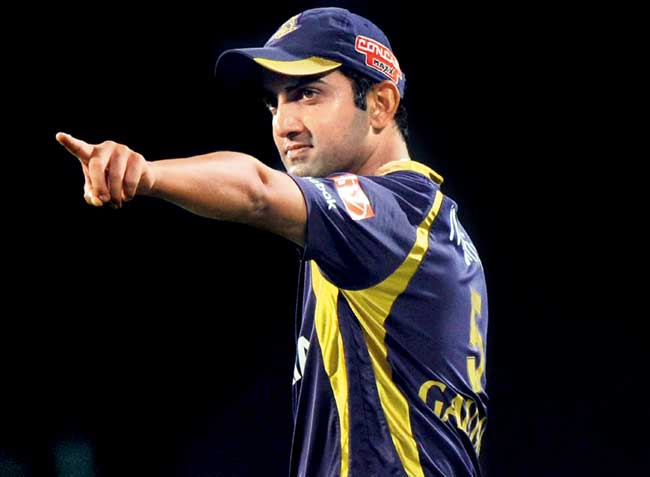While batting and bowling in T20s has evolved, the same can't be said about captaincy; rarely do we see a captain making an aggressive attempt to change the flow of a game, writes Aakash Chopra

KKR skipper Gautam Gambhir. Pic/AFP
Twenty20 cricket is designed to suit the aggressive brand of cricket, or so it has been perceived by the players and sold to the audience by its managers. Twenty overs of non-stop action in which every player brings forth his attacking instincts is what this format has become synonymous with.
KKR skipper Gautam Gambhir. Pic/AFP
Batsmen aren't shy of taking the aerial route or playing high risk shots right from the first ball bowled and successful T20 bowlers also believe that taking wickets is the best way to stem the flow of runs. While batting and bowling in this format has indeed evolved, the same can't be said about captaincy. Most captains are still allowing the game to run at its own pace and wait for the opportunities to come their way instead of creating them.
ADVERTISEMENT
Since the format dictates fluidity we do see captains making insane number of bowling changes and even innovative fielding positions but we rarely see the captain making an aggressive attempt to change the flow of the game. Once the batsmen go on a charge and a few find the middle of the willow, the most a captain does is summon his best bowler and expects a miracle.
Actually, how often do we see a batsman, irrespective of his ability to hit big shots, taking the aerial route off the first ball that he faces? Not too often, right? Then how many times do we see a captain bringing in more than the mandatory four fielders inside the circle for the first couple of balls that a batsman faces? Not too often again.
While we see some captains deploy a slip for the first couple of balls hoping for an outside edge, we still don't find enough captains backing their attacking intent to the hilt. Having a slip but only four in the circle is like going till the edge of the cliff but pulling out from taking that leap of faith. In fact, most of the time a wicket doesn't even change the field positions one bit.
New bowler, same field
The same bowler will bowl with the same field even to a new batsman. Now, that's how you allow the pace of the game to run the show instead of you running the game and the show. Gautam Gambhir is a reasonably attacking captain and has arguably the best T20 bowler at his disposal in Sunil Narine. While he always uses him as an attacking option, he rarely deploys more than four in the circle, even when the batsmen are struggling to put bat to ball.
In their first game against Chennai SuperKings, both Dwayne Bravo and MS Dhoni were at sea against him but Gambhir still had five patrolling the fence. Dhoni returned the favour in the second dig when Andre Russell and Ryan ten Doeschate had just walked in to bat. In another game, Perth Schorchers had Dolphins four down in the first six overs and it was quite apparent that another couple of wickets at that stage would've meant death knell for Dolphins but Scorchers still didn't force the issue.
Instead, they sat back trying to contain the non-existent run-flow. The lack of intent to create chances while fielding has spread like an epidemic in T20 cricket, and that's where Mohd Hafeez's captaincy was like a breath of fresh air.
Hafeez's positive intent
His intent to take wickets at all times is quite visible even from the outside. He had two slips and six inside the circle for Kieron Pollard when he walked in to bat against Wahab Riaz. He dared the batsman to go over the top before getting his eye in. Pollard was too concerned about his wicket and didn't take on the challenge, and that was Hafeez's victory.
Lahore Lions have a decent bowling line-up but they're always punching above their weight because Hafeez is constantly looking for wickets, for that makes the bowlers hit attacking lines and length. If the motive of a spinner is to stop the batsman from hitting fours/sixes, the line automatically becomes shorter and the trajectory, flatter.
And if the intent is to dismiss the batsman, you go fuller in search of a wicket and invariably get one too. Watching Lahore Lions in the field led by Hafeez is a delight because he rarely sits back and allows the game to drift. Instead, he makes a conscious effort to control and dictate the flow of the game. If other T20 captains take a cue from his book, T20 cricket will also have some scope for storytelling.
 Subscribe today by clicking the link and stay updated with the latest news!" Click here!
Subscribe today by clicking the link and stay updated with the latest news!" Click here!







